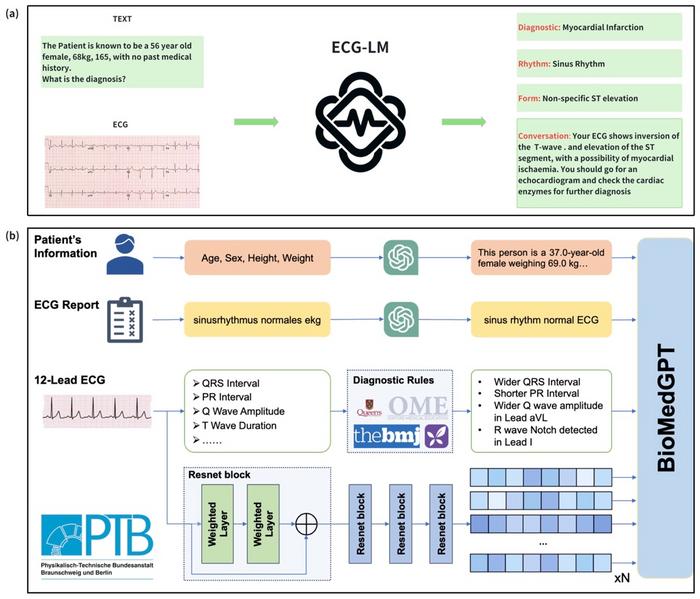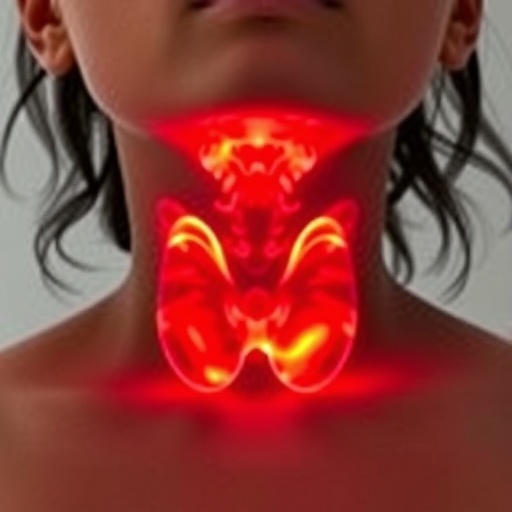
In a groundbreaking study, researchers from Tsinghua University and Beijing Tsinghua Changgung Hospital have unveiled a revolutionary method to enhance the interpretation of electrocardiogram (ECG) data through a model known as ECG-LM. This innovative approach harnesses the sophisticated abilities of large language models (LLMs) in interpreting complex ECG signals, promising to advance cardiovascular diagnostics significantly. The details of this transformative research were published in the esteemed journal Health Data Science. With this advancement, the team aims to redefine heart-related diagnoses, improving accuracy and accessibility for healthcare providers.
Electrocardiograms have long been a critical tool in clinical medicine, allowing healthcare professionals to monitor heart health and gain valuable insights into cardiovascular functioning. However, the interpretation of ECG data is no simple task. Accurately analyzing these readings often necessitates extensive medical knowledge, making the process both resource-intensive and prone to error. In environments where trained cardiologists are scarce, the manual interpretation of ECG readings can be slow and fraught with the potential for misdiagnosis.
Despite considerable progress in recent years, particularly with the application of deep learning techniques, a pressing need remains for more integrated models capable of analyzing ECG data along with patient information in tandem. This gap is precisely where the ECG-LM model sets itself apart, as it seamlessly combines state-of-the-art machine learning with LLMs to bridge this existing divide. The researchers have taken a bold step forward, combining deep learning methodologies with advanced language processing to enhance ECG interpretation.
The ECG-LM framework developed by the Tsinghua University research team represents a significant advancement in utilizing artificial intelligence within healthcare. By integrating the capabilities of LLMs, the ECG-LM model interprets ECG data in conjunction with vital patient-specific information, which includes medical history, presenting symptoms, and other relevant data. This multilayered approach facilitates more accurate and contextually nuanced diagnoses of various heart conditions, transforming how ECG data is utilized in clinical practice.
Delving into the intricacies of their model, the researchers employed deep learning techniques to develop a system capable of identifying subtle ECG patterns that traditional analysis methods might overlook. The extensive dataset utilized for training the model contained numerous ECG readings correlated with comprehensive clinical data. By identifying associations between the ECG signals and broader health trends, the ECG-LM model demonstrates an enhanced capacity to detect arrhythmias, heart attacks, and other cardiovascular issues, even in their earliest stages when symptoms may be minimal or nonexistent.
Through extensive clinical testing, the ECG-LM system has showcased considerable enhancements relative to conventional diagnostic tools. The model exhibited remarkable efficiency, processing ECG readings with increased speed and accuracy, while also generating probable diagnoses drawn from a multitude of patient data sources. The researchers’ rigorous evaluations indicate that ECG-LM not only outperforms traditional models in precision but also presents essential advantages in terms of operational efficiency, positioning it as a critical asset for healthcare practitioners, especially in high-volume or resource-limited settings.
Dr. Zaiqing Nie, the lead researcher at Tsinghua University, highlighted the broader implications of their findings, noting that this research marks a pivotal moment in cardiovascular medicine. By harnessing the capabilities of large language models, the team aims to accelerate the ECG interpretation process, making it faster and more reliable. Dr. Nie emphasized the potential impact on global healthcare, stating that improved diagnostic capabilities could save innumerable lives by providing timely and accurate assessments in a field that often deals with life-threatening conditions.
One of the most revolutionary aspects of the ECG-LM model is its potential to democratize advanced heart disease diagnostics, particularly in underserved regions that lack specialized medical personnel. By automating substantial portions of the diagnostic process, healthcare providers can devote more attention to direct patient care, ultimately fostering better health outcomes for individuals suffering from cardiovascular conditions. Such advancements stand to benefit global health significantly, particularly in areas where medical resources are constrained.
As promising as the ECG-LM model is, the research team recognizes that their work is merely the beginning. They plan to refine the model further by integrating additional data sources and enhancing its interpretability. The aim is to develop an even more user-friendly system for clinicians, ensuring that the technology can be seamlessly incorporated into existing healthcare workflows and addressing a wide range of healthcare applications beyond cardiology.
Collaboration represents another avenue of exploration for the researchers as they seek out partnerships with hospitals and healthcare providers interested in testing the ECG-LM system in real-world clinical environments. Ensuring that the model is primed for widespread deployment is a critical aspect of their future work. Dr. Nie explained that their efforts will concentrate on enhancing the model’s adaptability and interpretability, solidifying its status as an essential tool for medical practitioners in the field.
With the introduction of the ECG-LM model, Tsinghua University and Beijing Tsinghua Changgung Hospital are poised at the forefront of a transformative era in cardiovascular diagnostics. By leveraging the capabilities of large language models, these researchers are not only reimagining how ECG data is understood but also paving the way for significant advancements in clinical settings. Improved diagnostic accuracy, speed, and accessibility are now within reach, showcasing the incredible potential of AI within healthcare.
As the landscape of medical diagnostics continues to evolve, the ECG-LM model exemplifies a promising pathway for further advancements in electrocardiography and other areas of healthcare. The outcomes of this research serve as an inspirational blueprint for future innovations, demonstrating the substantial impact that interdisciplinary collaboration can have in tackling complex medical challenges and improving patient outcomes across the globe.
The excitement surrounding the ECG-LM model encapsulates a vision for the future of cardiovascular health, where smart, AI-driven tools become indispensable allies for healthcare professionals. With ongoing research and focus on refinement and collaboration, the path forward looks bright for ECG-LM and the critical radii of healthcare it seeks to serve.
By intertwining AI advancements with medical expertise, this research advances not only our understanding of ECG but also highlights the importance of innovative solutions in meeting the challenges of contemporary healthcare. The ECG-LM model is poised to serve as a vital resource in the medical field, ensuring the delivery of timely and accurate diagnoses that could save lives and redefine patient care for those at risk of cardiovascular diseases.
Subject of Research: ECG Data Interpretation Using Large Language Models
Article Title: ECG-LM: Understanding Electrocardiogram with a Large Language Model
News Publication Date: 4-Feb-2025
Web References: http://dx.doi.org/10.34133/hds.0221
References: Health Data Science
Image Credits: Zaiqing Nie, Institute for AI Industry Research (AIR), Tsinghua University
Keywords: Electrocardiography, Cardiovascular Diagnostics, Artificial Intelligence, Deep Learning, Medical Technology.
Tags: advanced language models in healthcaredeep learning for ECG interpretationECG data analysiselectrocardiogram interpretationhealthcare accessibility through technologyimproving heart health diagnosticsinnovative cardiovascular diagnosticsintegration of patient data in ECG analysismachine learning in cardiologyreducing misdiagnosis in cardiologytransformative healthcare solutionsTsinghua University research





